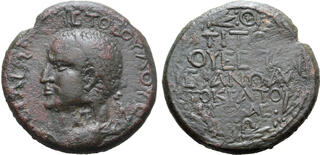| Roma Numismatics Ltd > E-Sale 114 | Auction date: 23 November 2023 |
| Lot number: 289 Price realized: Unsold | Show similar lots on CoinArchives Find similar lots in upcoming auctions on |
| Lot description: Kings of Armenia Minor, Aristoboulos Æ 25mm. Nikopolis-ad-Lycum, or Chalkis, dated year 17 = AD 70/1. BACIΛEΩC APICTOBOYΛOY ET IZ, diademed head to left; c/m: monogram within square incuse / TITΩ OΥECΠACIANΩ AYTOKPATΩP CEBACTΩ in six lines within wreath. Kovacs 301; Meshorer 367a; Hendin 1258; Sofaer 172; RG 3; RPC II 1692; for c/m, Kovacs 24 & Howgego pl. 33, 722.1. 11.30g, 25mm, 12h. Good Very Fine. Very Rare. Acquired from Gorny & Mosch Giessener Münzhandlung. Son of Herod of Chalkis and great-grandson of Herod I the Great, Aristoboulos hailed from the Herodian Dynasty of Roman vassal kings and in turn was granted the kingdom of Armenia Minor in AD 54 by the emperor Nero (Josephus 'Antiquities', XX.158). Though uncertain, his wife Salome is often identified as the young woman whom the New Testament relates danced for Herod the Great and, at the encouragement of her mother, received the severed head of John the Baptist in return (Matthew 14:1-12; Mark 6:14-29). The martyrdom by beheading of John the Baptist is a holy day observed by various Christian churches, and a theme often seen in art, sculpture, music and poetry. A loyal client king of Rome, Aristoboulos supported the general Gnaeus Domitius Corbulo in the Roman-Parthian War of AD 58-63, receiving a portion of Greater Armenia as reward, and in AD 73 supplied troops to the governor of Syria, Lucius Caesennius Paetus, who had persuaded the new emperor Vespasian that Antiochos IV of Commagene was planning to revolt and side with Vologases I of Parthia. Aristoboulos' decision to strike coins in only two years of his reign, years 13 (AD 66/7) and 17 (AD 70/1), as asserted by Kovacs, noted by Hendin (pg. 275), and proven by the clear date on a coin from the only other known issue of Aristoboulos, that which features dual portraits of himself and Salome (cf. Triton XIX, 277 and RPC I, 3839) is significant. The years AD 66 and AD 70 mark the beginning and end of the First Jewish-Roman War, as commemorated in the reverse of the present type which refers to Titus, whom Vespasian had left to suppress the revolt while he himself made his bid for imperial power. The two issues, struck at the beginning and end of the war, honouring first Nero and now Titus, probably therefore represent a public reaffirmation of Aristoboulos' loyalty to his Roman patrons. Also king of Chalkis from AD 57 until his death in 92, whereupon the region was absorbed into the Roman provincial territories, a mint location in Chalkis has been cited as a possibility for the production of Aristoboulos' coinage, though traditionally it has been noted as 'presumably' being from Nikopolis-ad-Lycum, where a specimen was acquired by F. Cumont c. 1900. Given the close proximity of Chalkis to the war in Judaea and the notable similarity in appearance and fabric of these coins to those of Chalkis, a mint location in Chalkis cannot be discounted. Estimate: 2500 GBP |  |


